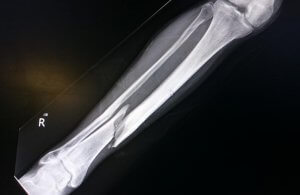BROKEN LEG ACCIDENT – TIBIA FRACTURE INJURY COMPENSATION ATTORNEYS
Our accident injury lawyers frequently handle cases involving a broken tibia or fibula. The shinbone, a/k/a the tibia, is the long bone located in the lower leg between the knee and foot. In some cases, the only symptom of a tibia fracture is a pain in the shin while walking.
In severe cases, the broken tibia bone may protrude through the skin. Of course, the recovery and healing time for tibial fractures depends on the type and severity of the fracture.
Our personal injury lawyers have successfully represented many people with a fractured tibia or broken leg from a car accident or slip and fall accident throughout Minnesota. To start with, we make sure medical bills are paid and lost wages are reimbursed. In addition, we get clients compensation for pain, suffering, and inconvenience.
The tibia plays a key role in supporting a person’s body weight. According to the American Academy of Orthopedic Surgeons, the tibia is the most common long bone in the body to fracture. A tibia fracture refers to any crack or break in the tibia bone.
The tibia plays a key role in body mechanics, as it is:
- the larger of the two lower leg bones
- responsible for supporting most of the body weight
- vital for proper knee and ankle joint mechanics

A fractured tibia often occurs with other kinds of tissue damage to the nearby muscles or ligaments. It should always be checked out by a medical professional.
Types of tibia fracture
Our accident lawyers have worked on many different types of tibia fracture or broken leg cases. The fracture may be located in several places: It may be a transverse fracture, meaning the crack is horizontal across the bone. By contrast, an oblique fracture means the crack is at an angle. Proximal fractures are those that affect the upper part of the tibia. Tibia shaft fractures occur below this area. An experienced accident attorney understands the seriousness of these injuries. We get you full compensation for medical bills, lost wages, and other harms.
The tibia can have the following types of fracture:
- Stable fracture. A stable fracture involves a crack in the bone that leaves most of the bone intact and in its normal position. This is also called a non-displaced fracture.
- Displaced fracture. With a displaced fracture, a crack in the bone separates part of the bone so that it is no longer aligned. Surgery is often needed to correct this type of fracture.
- Stress fracture. Stress fractures, also called hairline fractures, are common overuse injuries. These fractures are small, thin cracks in the bone.
- Spiral fracture. When a twisting movement causes a break, there may be a spiral-shaped fracture of the bone.
- Comminuted fracture. When the bone fractures into three or more pieces, this is called a comminuted fracture. Of course, this also requires surgery.
COMPOUND LEG FRACTURE
When bones are broken, they can either stay under the skin or break through its surface. Open fractures are fractures where a broken bone breaks through the skin. With closed fractures, the bone does not break the skin, though there may still be internal tissue damage.
Symptoms of a fractured tibia may include:
- localized pain in one area of the tibia or several areas if there are multiple fractures
- lower leg swelling
- difficulty or inability to stand, walk, or bear weight
- leg deformity or uneven leg length
- bruising or discoloration around the shinbone
- sensation changes in the foot
- bone protruding through the skin
- a tent-like appearance where the skin is being pushed up by the bone
Diagnostic tests may include:
- an X-ray to have an image of the tibia
- computed tomography (CT) scan, also called a CAT scan, which is more powerful than an X-ray and gives a 3-D image of the bone
- magnetic resonance imaging (MRI) scan gives a more detailed image of the muscles, ligaments, and bones around the tibia
An MRI scan is often used if the other scans have not been able to diagnose the problem.
Treatment For Tibia Fracture / Broken Leg In Accident:
Treatment of a tibia fracture depends on several factors. For example, a person’s overall health at the time of the injury must be considered. Also, the cause and severity of the injury, and the presence or extent of damage to the soft tissues that surround the tibia.
In more serious broken leg cases, surgery is necessary to make sure the bone heals properly. A surgeon may place metal screws and plates on the bone to hold it in the right place. This allows the broken leg to heal with minimal long-term damage. The surgeon may also use rods placed inside the tibia or pins placed through the bones above and below the fracture. They will attach these to a rigid frame called an external fixator to hold the bone in place. The cost of the surgery and recovery can be substantial. Therefore, an accident attorney will have to fully present the case to the insurance company to get the client full compensation.
Where surgery is not necessary or is not possible, for instance, due to a person’s health, a doctor may treat a fractured tibia differently:
- A splint or cast to hold the bone in place, stop it from moving and allow it to heal. The splint can be removed easily and so it is a more flexible treatment option than surgical ones.
- A traction or functional brace, which is used in cases of less severe breaks to hold the bone in place while it heals.
In many cases, a person with a tibial fracture will require physical therapy and crutches or a walker to help them get back on their feet.
Recovery After Broken Leg / Tibia Fracture
Recovery from a tibial fracture varies based on the severity of the fracture. A person will often recover within 4 to 6 months. Recovery time may be longer for a complete break compared to a partial one and may take longer if a person has poor health for other reasons. It may take longer than this time frame for a person to be able to return to their normal activities. Our injury lawyers will work with you so the insurance company understands what you have gone through.
People should always follow their doctor’s recommendations about returning to walking, exercising, and other physical activity after a leg fracture. Our accident lawyers help to recover lost income for people who are out of work because of a broken leg.
Certain exercises can help to take the pressure off the tibia bone, such as exercises that strengthen the hips, calves, and thighs. This protection may also prevent future injuries from happening.
Complications From Tibia Fracture
Complications of a tibia fracture may include:
- Unexpected issues from the surgery or the need for further surgeries
- nerve, muscle, or blood vessel damage
- compartment syndrome, a serious condition which there is a reduction in blood supply to the leg due to swelling
- a bone infection called osteomyelitis
- development of a non-union where the bone does not heal
In many cases, a tibial fracture will be successfully managed without complication. The long-term outlook for a tibia fracture is usually good but depends on the severity of the injury and other health-related factors. Doctors will be able to provide a person with a long-term outlook during the evaluation and healing process as their leg recovers.
Lawyer for Broken Leg In Accident / Tibia Fracture
If you broke your leg or tibia in an auto accident, slip and fall accident, or other accident that was another person’s fault, call us and speak with a top injury lawyer for a free consultation. Our lawyers have represented hundreds of people in Minneapolis, St. Paul and throughout MN in accident cases for over 25 years. We will make sure you get the compensation you are entitled to.
